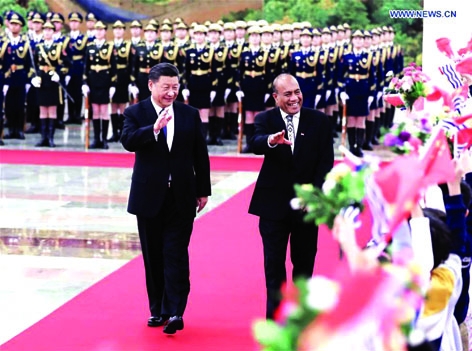MOTIVES FOR PROVIDING AID
Competition for diplomatic recognition has driven China’s and Taiwan’s aid programmes in the Pacific. Aid has been used as a tool for both sides to garner support. China insists its aid to recipients should be understood in terms of SouthSouth cooperation and is mutually beneficial. The Chinese government regards PICs as part of the greater periphery in its diplomacy and the southern extension of the Belt and Road Initiative (BRI). The China–Oceania–South Pacific blue economic passage is seen as part of what is termed ‘the 21st century maritime silk road’ that will travel southward from the South China Sea into the Pacific.
Besides bolstering its diplomatic relations, Taiwan’s white paper on foreign aid emphasises that providing foreign aid is a means for Taiwan, which was once a beneficiary of foreign aid from the United States and Japan among others, to give back to the international community and also to share Taiwan’s developmental experience with partner countries. Given four of Taiwan’s remaining 15 diplomatic allies are from the Pacific (Marshall Islands, Nauru, Palau and Tuvalu), the importance of the region to Taiwan is self-evident. Taiwan has been seeking to strengthen relations with PICs through its New Southbound Policy introduced by President Tsai Ing-wen in 2016 and to highlight the shared cultural and linguistic links between the two sides.
While most of China’s and Taiwan’s aid goes to their diplomatic allies, both also provide a limited amount of aid to countries with no diplomatic ties.
TYPES OF AID
Bilateral aid dominates aid from China and Taiwan to the Pacific region. The majority of Chinese aid goes into largescale infrastructure projects in the form of concessional loans such as the US$46 million for constructing the Goroka University dormitory (phases 2–4) in Papua New Guinea. This has sparked debate about the indebtedness of PICs. In comparison, Taiwan’s aid has focused on technical assistance in agriculture and health, government scholarships and small- to medium-sized infrastructure such as a solar power plant in Nauru. Taiwan also uses aid to promote people-to-people links. In August 2013, Taiwan’s Institute of Diplomatic and International Affairs and the East-West Center in Hawai‘i launched a five-year Pacific Islands Leadership Programme with Taiwan which was extended for another five years. By 2018, a total of 144 Pacific youth leaders had participated in the programme, including from all eight PICs that recognise China.
Until September 2019, Taiwan had delivered about 70 percent of its Solomon Islands aid budget through rural constituency development funds. The fact that Taiwan had paid scant attention to mega-infrastructure had apparently been resented; the parliamentary bipartisan task force complained that ‘Taiwan will not do anything substantial in infrastructure development to support the economic growth of Solomon Islands.’ China has promised to provide aid to Solomon Islands in sectors such as infrastructure, constituency development funds, scholarships and the 2023 Pacific Games.
Both China and Taiwan provide aid predominantly throughgovernment channels. For China, the only civil society organisation involved is the government-backed China Red Cross, which provides donations to PICs at times of natural disasters. In Taiwan, the Taiwan Alliance in International Development (Taiwan AID), an umbrella organisation for nearly 30 Taiwanese NGOs working overseas, assists aid delivery. Both circumvent sensitive areas such as democracy, human rights and governance in PICs. Some aid experts from Taiwan AID suggest Taiwan adopt a human rights-based approach and allow civil society organisations to play a greater role in aid delivery to differentiate Taiwan from China’s tight control of such organisations overseas. The diplomatic tug-of-war between China and Taiwan is expected to intensify in the Pacific in the foreseeable future. China seeks to have the upper hand and utilise its political and economic leverage, including through aid and the BRI, to win over Taiwan’s diplomatic allies. For Taiwan, it is likely to use aid to prevent a domino effect after Solomon Islands and Kiribati switched to China. Having a smaller number of diplomatic allies means Taiwan now has more aid resources at its disposal in the Pacific.
This version of the Department of Pacific Affairs In Brief
2019/20 appeared first on Devpolicy Blog, devpolicy.org, from
the Development Policy Centre at The Australian National
University.
Denghua Zhang is a Research Fellow at the Department of
Pacific Affairs at ANU.
editor@islandsbusiness.com
